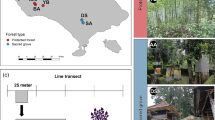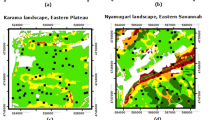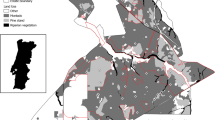Abstract
In Neotropical forests, dung beetles act as efficient secondary dispersers of seeds that are dispersed primarily by red howler monkeys. Here, we investigated the origins of soil seed bank variability in relation to monkey and dung beetle activity, to assess the impact of dung beetles on seed fate, and their adaptability to resource availability. This question is important to better understand the process of tree regeneration, and is especially timely in the current context of threat to primates. We characterized soil seed bank structures in sites differing in monkey frequentation, and conducted field experiments with artificial beads to monitor bead fate. We also conducted experiments on specific roller and tunneller beetle species to examine bead processing behavior and its variability among and within species. We found that seed number and diversity increased with monkey frequentation, but seed viability was optimal under moderate monkey frequentation. We showed for the first time that dung provisioning yielded higher beetle activity in sites more often visited by monkeys, which calls for further investigation to understand the mechanisms of attraction to resource and potential spatial structuration of beetle populations. Although all beetle species involved in the experiments actively excluded beads from dung reserves, selectivity was higher for small than large beetle species, and for large compared to small bead sizes. It also increased when per-capita dung resource decreased, suggesting that intraspecific competition could alter seed fate. Altogether, our results support a major role of dung beetles in soil seed bank structure and dynamics. They reveal interesting interspecific variability within the dung beetle community and a complex interplay with primary dispersal.



Similar content being viewed by others
References
Andresen E (1999) Seed dispersal by monkeys and the fate of dispersed seeds in a Peruvian rainforest. Biotropica 31:145–158
Andresen E (2002) Dung beetles in a Central Amazonian rainforest and their ecological role as secondary seed dispersers. Ecol Entomol 27:257–270
Andresen E, Feer F (2005) The role of dung beetles as secondary seed dispersers and their effect on plant regeneration in tropical rainforests. In: Forget P-M, Lambert JE, Hulme PE, Vander Wall SB (eds) Seed fate: predation, dispersal and seedling establishment. CAB International, Wallingford, pp 331–350
Andresen E, Levey DJ (2004) Effects of dung and seed size on secondary dispersal, seed predation, and seedling establishment of rain forest trees. Oecologia 139:45–54
Bolker BM, Brooks ME, Clark CJ, Geange SW, Poulsen JR, Stevens MHH, White J-SS (2009) Generalized linear mixed models: a practical guide for ecology and evolution. Trends Ecol Evol 24:127–135
Borza JK, Westerman PR, Liebman M (2007) Comparing estimates of seed viability in three foxtail (Setaria) species using the imbibed seed crush test with and without additional tetrazolium testing. Weed Technol 21:518–522
Burnham KP, Anderson DR (1998) Model selection and inference. A practical information theoretic approach. Springer, New York
Charles-Dominique P (2001) The field station. In: Bongers F, Charles-Dominique P, Forget P-M, Théry M (eds) Nouragues: dynamics and plant–animal interactions in a neotropical rainforest. Kluwer, Dordrecht, pp 1–7
Dalling JW (2005) The fate of seed banks: factors influencing seed survival for light-demanding species in moist tropical forests. In Forget P-M, Lambert JE, Hulme PE, Vander Wall SB (eds) Seed fate: predation, dispersal and seedling establishment. CAB International, Wallingford, pp 31–44
Dalling JW, Swaine MD, Garwood NC (1994) Effect of soil depth on seedling emergence in tropical soil seed-bank investigations. Funct Ecol 9:119–121
Dalling JW, Swaine MD, Garwood NC (1998) Dispersal patterns and seed bank dynamics of pioneer trees in moist tropical forest. Ecology 79:564–578
Decaëns T, Mariani L, Betancourt N, Jimenez JJ (2003) Seed dispersion by surface casting activities of earthworms in Colombian grasslands. Acta Oecol 24:175–185
Dos Santos NevesN, Feer F, Salmon S, Chateil C, Ponge J-F (2010) The impact of red howler monkey latrines on the distribution of main nutrients and on topsoil profiles in a tropical rain forest. Aust Ecol 35:549–559
Engel TR (2000) Seed dispersal and forest regeneration in a tropical lowland biocenosis (Shimba Hills, Kenya). Logos, Berlin
Estrada A, Coates-Estrada R (1991) Howler monkeys (Alouatta palliatta), dung beetles (Scarabaeidae) and seed dispersal: ecological interactions in the tropical rain forest of Los Tuxtlas, Mexico. J Trop Ecol 7:459–474
Favrichon V (1994) Classification des espèces arborées en groupes fonctionnels en vue de la réalisation d’un modèle de dynamique des peuplements en forêt guyanaise. Rev Ecol 49:379–403
Feeley K (2005) The role of clumped defecation in the spatial distribution of soil nutrients and the availability of nutrients for plant uptake. J Trop Ecol 21:99–102
Feer F (1999) Effects of dung beetles (Scarabaeidae) on seeds dispersed by howler monkeys (Alouatta seniculus) in the French Guianan rain forest. J Trop Ecol 15:1–14
Feer F (2000) Les Coléoptères coprophages et nécrophages (Scarabaeidae s. str. et Aphodiidae) de la forêt de Guyane française: composition spécifique et structure des peuplements. Ann Soc Entomol Fr 36:29–43
Feer F, Pincebourde S (2005) Diel flight activity and ecological segregation within an assemblage of tropical forest dung and carrion beetles. J Trop Ecol 21:21–30
Finn JA, Gittings T (2003) A review of competition in north temperate dung beetle communities. Ecol Entomol 28:1–13
Gill BD (1991) Dung beetles in tropical American forests. In: Hanski I, Cambefort Y (eds) Dung beetle ecology. Princeton University Press, NJ, pp 211–229
Giller PS, Doube BM (1989) Experimental analysis of inter- and intraspecific competition in dung beetle communities. J Anim Ecol 58:129–142
Grimaldi M, Riéra B (2001) Geography and climate. In: Bongers F, Charles-Dominique P, Forget P-M, Théry M (eds) Nouragues: dynamics and plant–animal interactions in a neotropical rainforest. Kluwer, Dordrecht, pp 9–18
Hanski I, Cambefort Y (1991) Dung beetle ecology. Princeton University Press, Princeton
Jones MB (1994) Secondary seed removal by ants, beetles, and rodents in a Neotropical moist forest. University of Florida, MSc Dissertation
Julliot C (1992) Utilisation des ressources alimentaires par le singe hurleur roux, Alouatta seniculus (Atelidae, Primates), en Guyane: impact de la dissémination des graines sur la régénération forestière. University of Tours, France, PhD Dissertation
Julliot C (1994) Frugivory and seed dispersal by red howler monkeys: evolutionary aspect. Rev Ecol 49:331–341
Julliot C (1996a) Fruit choice by red howler monkeys (Alouatta seniculus) in a tropical rain forest. Am J Primat 40:261–282
Julliot C (1996b) Seed dispersal by red howler monkeys (Alouatta seniculus) in the tropical rain forest of French Guiana. Int J Primat 17:239–257
Julliot C (1997) Impact of seed dispersal by red howler monkeys Alouatta seniculus on the seedling population in the understorey of tropical rain forest. J Ecol 85:431–440
Julliot C, Sabatier D (1993) Diet of the howler monkey (Alouatta seniculus) in French Guiana. Int J Primatol 14:527–550
Julliot C, Simmen B, Zhang S (2001) Frugivory and seed dispersal by three neotropical primates: impact on plant regeneration. In: Bongers F, Charles-Dominique P, Forget P-M, Théry M (eds) Nouragues: dynamics and plant–animal interactions in a neotropical rainforest. Kluwer, Dordrecht, pp 197–205
Larsen T, Williams NM, Kremen C (2005) Extinction order and altered community structure rapidly disrupt ecosystem functioning. Ecol Lett 8:538–547
Lawson CR, Mann DJ, Lewis OT (2012) Dung beetles reduce clustering of tropical tree seedlings. Biotropica 44:271–275
Lobova TA, Mori SA, Blanchard F, Peckham H, Charles-Dominique P (2003) Cecropia as food resource for bats in French Guiana and the significance of fruit structure in seed dispersal and longevity. Am J Bot 90:388–403
Marthews TR, Mullins CE, Dalling JW, Burslem FRP (2008) Burial and secondary dispersal of small seeds in a tropical forest. J Trop Ecol 24:595–605
Muñoz Lazo FJJ, Culot L, Huynen M-C, Heymann EW (2011) Effect of resting patterns of tamarins (Saguinus fuscicollis and Saguinus mystax) on the spatial distribution of seeds and seedling recruitment. Int J Primatol 32:223–237
Pearson TRH, Burslem FRP, Mullins CE, Dalling JW (2003) Germination ecology of neotropical pioneers: interacting effects of environmental conditions and seed size. Ecology 83:2798–2807
Peck SB, Forsyth A (1982) Composition, structure and competitive behaviour in a guild of Ecuadorian rain forest dung beetles (Coleoptera: Scarabaeidae). Can J Zool 60:1624–1634
Pizo MA, Oliveira PS (1999) Removal of seeds from vertebrate faeces by ants: effects of seed species and deposition site. Can J Zool 77:1595–1602
Pizo MA, Passos L, Oliveira PS (2005) Ants as seed dispersers of fleshy diaspores in Brazilian Atlantic forests. In: Forget PM, Lambert JE, Hulme PE, Vander Wall SB (eds) Seed fate: predation, dispersal and seedling establishment. CAB International, Wallingford, pp 315–329
Poncy O, Sabatier D, Prévost M-F, Hardy I (2001) The lowland high rainforest: structure and tree species diversity. In: Bongers F, Charles-Dominique P, Forget P-M, Théry M (eds) Nouragues: dynamics and plant–animal interactions in a neotropical rainforest. Kluwer, Dordrecht, pp 31–46
Pouvelle S, Feer F, Ponge J-F (2008) Topsoil as affected by dung deposition under resting places of red howler monkey (Alouatta seniculus). Pedosphere 18:691–698
Pouvelle S, Jouard S, Feer F, Tully T, Ponge J-F (2009) The latrine effect: impact of howler monkeys on the distribution of small seeds in a tropical rain-forest soil. J Trop Ecol 25:239–248
R Development Core Team (2011) R: a language and environment for statistical computing. R Foundation for Statistical Computing, Vienna, Austria. ISBN 3-900051-07-0, http://www.R-project.org/
Shepherd VE, Chapman CA (1998) Dung beetles as secondary seed dispersers: impact on seed predation and germination. J Trop Ecol 14:199–215
Simmen B, Julliot C, Bayart F, Pagès-Feuillade E (2001) Diet and population densities of the primate community in relation to fruit supplies. In: Bongers F, Charles-Dominique P, Forget P-M, Théry M (eds) Nouragues: dynamics and plant–animal interactions in a neotropical rainforest. Kluwer, Dordrecht, pp 89–101
Slade EM, Mann DJ, Villanueva JF, Lewis OT (2007) Experimental evidence for the effects of dung beetle functional group richness and composition on ecosystem function in a tropical forest. J Anim Ecol 76:1094–1104
Tirado Herrera ER, Vulinec K, Knogge C, Heymann EW (2002) Sit and wait at the source of dung—an unusual strategy of dung beetles. Ecotropica 8:87–88
Vander Wall SB, Longland WS (2004) Diplochory: are two seed dispersers better than one? Trends Ecol Evol 19:155–161
Vulinec K (2000) Dung beetles (Coleoptera: Scarabaeidae), monkeys, and conservation in Amazonia. Florida Entomol 83:229–241
Vulinec K (2002) Dung beetle communities and seed dispersal in primary forest and disturbed land in Amazonia. Biotropica 34:297–309
Wenny DG (2001) Advantages of seed dispersal: a re-evaluation of directed dispersal. Evol Ecol Res 3:51–74
Acknowledgments
We are indebted to the staff of the Nouragues Research Station (CNRS, French Guiana), for commodities and technical help during the field session. We thank P.-Y. Henry for useful comments on data analysis and the anonymous reviewers for comments on the manuscript. Financial support was provided by the National Museum of Natural History (Paris, France) and the CNRS (UMR 7179).
Author information
Authors and Affiliations
Corresponding author
Electronic supplementary material
Below is the link to the electronic supplementary material.
About this article
Cite this article
Feer, F., Ponge, JF., Jouard, S. et al. Monkey and dung beetle activities influence soil seed bank structure. Ecol Res 28, 93–102 (2013). https://doi.org/10.1007/s11284-012-1006-9
Received:
Accepted:
Published:
Issue Date:
DOI: https://doi.org/10.1007/s11284-012-1006-9




